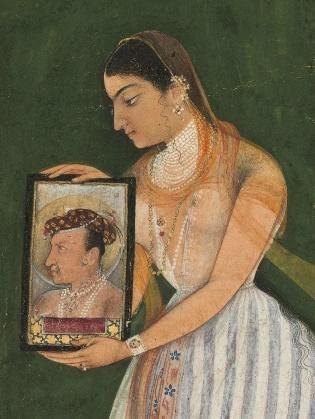
PUMPA - SMART LEARNING
எங்கள் ஆசிரியர்களுடன் 1-ஆன்-1 ஆலோசனை நேரத்தைப் பெறுங்கள். டாப்பர் ஆவதற்கு நாங்கள் பயிற்சி அளிப்போம்
Book Free DemoThe Successor of Akbar - Jahangir
- After Akbar's demise, the throne of the Mughal empire was handed over to Jahangir, who ruled the empire from \(1605 – 1627\). He was also called “Salim” and his name Jahangir means “Conqueror of the World”.
- Jahangir was not interested in military conquests and territorial expansion as he had his interests inclined towards Art and Architecture.

Noor Jahan holding Jahangir’s portrait
- Noor Jahan, the wife of Jahangir, was the real ruler at that time under the titular name of Jahangir.
MEHRUNISSA: Noor Jahan, Jahangir's wife, also had another name, “Mehrunissa” (Light of the world).
Jahangir’s tussle with Sikhs
- Jahangir’s issues with Sikhs cropped up when Jahangir ordered the killing of the fifth Sikh Guru, “Guru Arjun dev”, as he was giving religious advice for the elder son of the Jahangir, Khurram.
- Khurram started to rebel against his father, where he was arrested and kept behind bars by Jahangir.
- The killing of the Sikh guru irked the Sikh rulers, and the enmity between the groups extended for a long time. This issue cost the Mughals the trade routes in Western Asia.
The Arrival of British:
- The British visited India during the reign of Jahangir to expand their trade activities. Captain Hawkins, the head of British troops, sent Sir Thomas Roe to the court of Jahangir.
- Jahangir granted the “Farman (Royal Permit)” to Sir Thomas Roe, enabling the British to open their first factory at Surat in \(1614\).
TUSUK-I-JAHANGIRI: This is the Auto-Biography of Jahangir written by the emperor in the Persian Language.
The artistic side of Jahangir:
- Jahangir spent more time decorating the buildings and constructing new edifices during his reign.
- During his tenure, he built “Moti Masjid at Lahore, Shalimar and Nishant Bagh gardens at Kashmir.
PIETRA DURA: This is a decoration of inner structures with floral designs, which was the unique feature of Jahangir’s architecture.
The habit of drawing Halo or divine lights behind the emperor’s head began during Jahangir’s reign.
Jahangir also gave importance to Justice under his reign, where he established a hall at Agra for the seekers of Royal Justice.
Jahangir also gave importance to Justice under his reign, where he established a hall at Agra for the seekers of Royal Justice.
Shah Jahan: (1628 – 1658)
- Khurram, the rebel prince, gained the throne after his father’s death. He ruled the empire under the title “Shah Jahan”. He married “Mumtaj” who died in \(1631\), under whose remembrance the Taj Mahal at Agra was built.
- He led various expeditions and had mixed success during his reign. He is highly intolerant towards other religions, which shows a marked difference from the characters of his father Jahangir and his Grandfather Akbar.
SHAHJAHAN NAMA: It was a eulogy written in Praise of Shah Jahan by Inayat khan, court poet of the ruler.
Shah Jahan’s Deccan Conquests:
- The ruler’s Deccan policy was highly successful as he invaded and conquered Ahmednagar in \(1632\). The other Deccan sultanates of Golconda and Bijapur signed a treaty with Shah Jahan.

Shah Jahan
- Maratha administrators supported the Deccan sultanates, and thus the enmity between the Marathas and the Mughals raised to new heights, and it prolonged for an extended period.
- The Uzbek rulers thwarted Shah Jahan’s move to capture the Balkh area. At the same time, he lost Qandahar to the Safavid rulers.
Art and Architecture:
- Shah Jahan had a high penchant towering the palace and halls, which ignited him to construct many architectural marvels during his reign. Some of them are given below,
1. Taj Mahal
2. Red fort
3. Jama Masjid
4. Chandni Chowk - He also went on to build a new city named “Shahjahanabad” which later became his capital.
- The ruler met his end after the deterioration of health in 1657, when he was imprisoned by his son.